Southern Bentwing Bats Miniopterus schreibersii bassanii at Naracoorte Caves National Park, South Australia
Research, Conservation, Interpretation
Director Operations Naracoorte Lucindale Council
Email: steve.bourne@nlc.sa.gov.au
Abstract
Bat Cave, in Naracoorte Caves National Park, is one of only two known maternity caves for the Southern Bentwing Bat Miniopterus schreibersii bassanii, hence site protection is essential for the long-term survival of the species. The park is a major regional tourism site, attracting over 40,000 visitors each year, providing an excellent opportunity for raising awareness of bats. Many years’ research has been completed at the park, contributing important information to our understanding of the species.
The Department for Environment and Heritage installed infrared camera technology on a permanent basis into Bat Cave at Naracoorte Caves in 1995, thereby developing an excellent non-intrusive wildlife experience. The innovation has been well received by visitors to the park and advances in technology have allowed several upgrades, greatly improving the quality of presentations.
Importantly, the Bat Observation Centre provides a forum for the presentation of research that has been undertaken at the park. Apart from the bats themselves, researchers have also investigated invertebrates and land use of the region and each project contributes to the information presented on guided tours.
This paper summarises 20 years of research and presentation of Bat Cave, Naracoorte.
Introduction
Bat Cave at Naracoorte Caves National Park, South Australia, is one of only two known maternity sites for the Southern Bentwing Bat Miniopterus schreibersii bassanii. Although the park is best known for extensive fossil deposits of Pleistocene Megafauna that led to inscription on the World Heritage list in 1994, bats also feature prominently in the park’s research, management strategies and interpretation.
The Bat Cave population is one of the most studied bat populations in Australia, yet paradoxically, many gaps remain in our knowledge. In particular, the population decline that occurred sometime between the 1960s and 2000; how large this decline has been and causes for it, remain elusive despite considerable research effort. Technological advances are assisting in population monitoring, but flaws remain in how these data are collected.
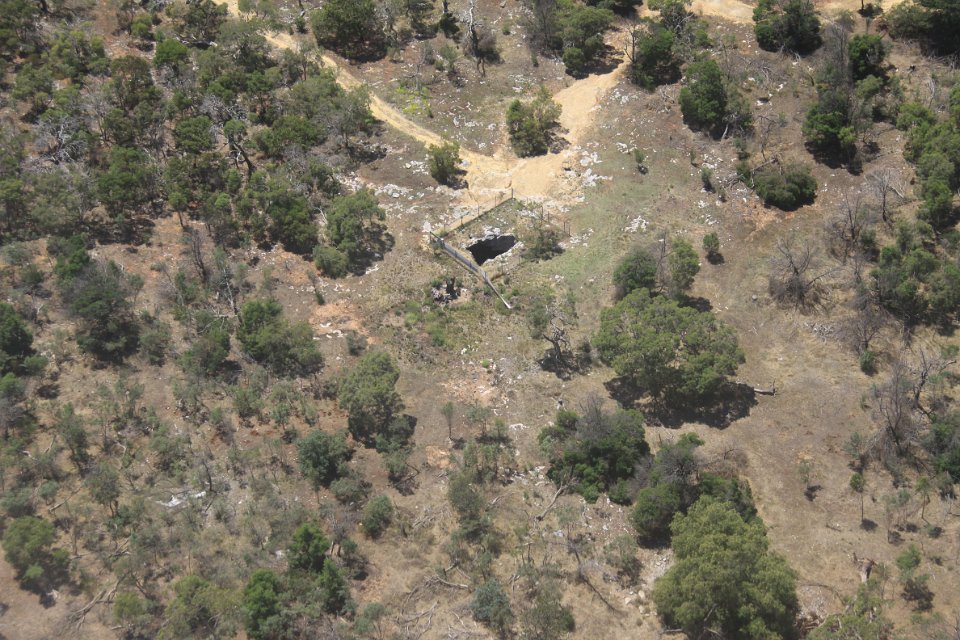
Figure 1: Aerial view of Bat Cave, Naracoorte 2011.
Visitors to the park prior to the 1960’s often accessed Bat Cave although it appears it was never part of the structured visitor program. This no doubt caused considerable disturbance to the bats although there is little mention of the bats themselves in most accounts. Evening guided tours commenced in 1985 where visitors were taken to the entrance of Bat Cave during the summer months to witness the exit flight. In 1995, four infrared cameras were installed in Bat Cave and visitors could view real time images with no disturbance to the bats. Advances in technology have since allowed several upgrades and the Bat Observation Centre remains a major component of the guided tour program.
Interpretation in the Bat Observation Centre involves interpreting behaviours observed and provides the perfect forum for disseminating research. Bat Cave is one of the most studied bat sites in Australia (Bourne, 2010 and Bourne, 2010a) and investigations have taken many different angles. Many questions visitors ask are ones that researchers are trying to determine as well, such as “how many bats live in the cave?” Integration of this research into the interpretation keeps the product current and relevant.
Bat Cave is a well-protected site with restricted access, with no easy means for unauthorised access and pest control programs in place to minimise feral animals such as cats and rats. Greater conservation issues exist beyond the park for the Southern Bentwing Bats with over 50 known wintering caves, many on private land. The Friends of Naracoorte Caves group embarked on a project to restore two wintering sites and develop a brochure to raise awareness of bats and their requirements.
Research, conservation and interpretation of bats are closely linked at Naracoorte Caves. This paper summarises the research and conservation efforts undertaken on and near the park.
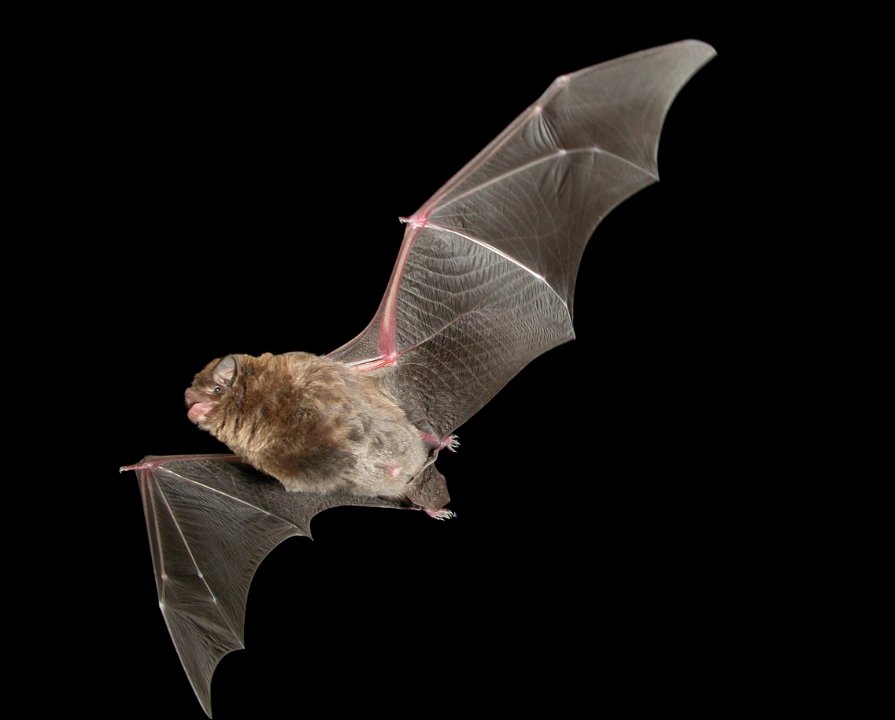
Figure 2: Miniopterus schreibersii bassanii
Determining the population of Southern Bentwing Bats
Early accounts of Bat Cave from when the Naracoorte Caves were first visited by Europeans in the mid 1800s remarkably largely ignore the bats, even after the first on site manager was engaged in 1885. The second park manager, William Redden successfully brought guano mining under control (Hamilton-Smith, 1998) but made little comment on the numbers of bats. This means we have little idea of numbers prior to a count by Dwyer and Hamilton-Smith in 1963-64 (Dwyer & Hamilton-Smith, 1965). They estimated the population to be 100-200,000 based on a mark recapture project and by estimating the number of pups on the cave ceiling. The original data has been lost, but the process of data collection was described by Hamilton-Smith in a note to the author as a contribution to a workshop held at the 2008 Australasian Bat Society conference.
In our studies at Naracoorte, three different methods were utilised in our attempts to count the number of bats. The first was use a mask to look at various small sections of the exit flight from below the cave entrance. The mask was designed to allow only a view of approximately 1% of the whole and we simply counted the number of bats seen though that space.
The second was the familiar mark-recapture system. This proved problematic as we found evidence that there was some kind of social organisation which led to at least some bats roosting and flying in more-or-less stable clusters.
The third was to both measure the roof area covered by the juvenile animals and count the number of individuals per square foot over a number of sample areas. The total estimate of juveniles which resulted were then used as the basis for estimating the whole, using the gender/age composition which we had found in catching large numbers of bats for banding purposes.

Figure 3: Harp trap set up in Bat cave during the 1960s bat banding project.
This count seems to have set the population base, which interestingly increased about 50,000 per decade in population estimates used in interpretive and promotional material until 2000, when the number was 400,000. One grossly exaggerated claim of 750,000 was even used of a park guide in the mid 1970s.
The Action Plan for Australian Bats (Duncan et al., 1999) states “the number of bats currently using the Naracoorte Bat Cave (100,000-200,000 in December) is similar to estimates from the 1960s”. No counts or even an estimate using any scientific methodology were used to substantiate this claim. Counts commenced the following year highlight the value of long term population monitoring.
Reardon et al. undertook a count using mark-recapture methodology in 2000 and the population was estimated to be 35-76,000 (Reardon, 2001). The program was quite disruptive to the bats, with individuals and small groups not returning to Bat Cave after a night’s feeding. This was despite a careful approach and strategies in place to minimise stress to the bats. Some individuals were observed in chambers at Blackberry Cave, where they had not previously been seen nor since. Apart from the disruption, the dispersal greatly reduced the accuracy of the count.
Annual video counts by Grant and Reardon from 2001 to 2004 placed the population in the vicinity of 30-33,000 in January, just before the season’s pups commence flights outside the cave, with a substantial decline to 22-25,000 recorded in 2008 and 2009. Although time consuming, this method is quite accurate, but only provided a snapshot on one or two nights per year.
The Bat Cave colony along with that at Starlight Cave, Warrnambool, Victoria, was elevated to a subspecies of Miniopterus schreibersii following genetic investigations (Cardinal & Christidis, 2000, Appleton et al., 2004). The severe population reduction and elevating the colonies to the subspecies Miniopterus schreibersii bassanii led to the listing of the sub species as critically endangered under the EPBC Act 1999.
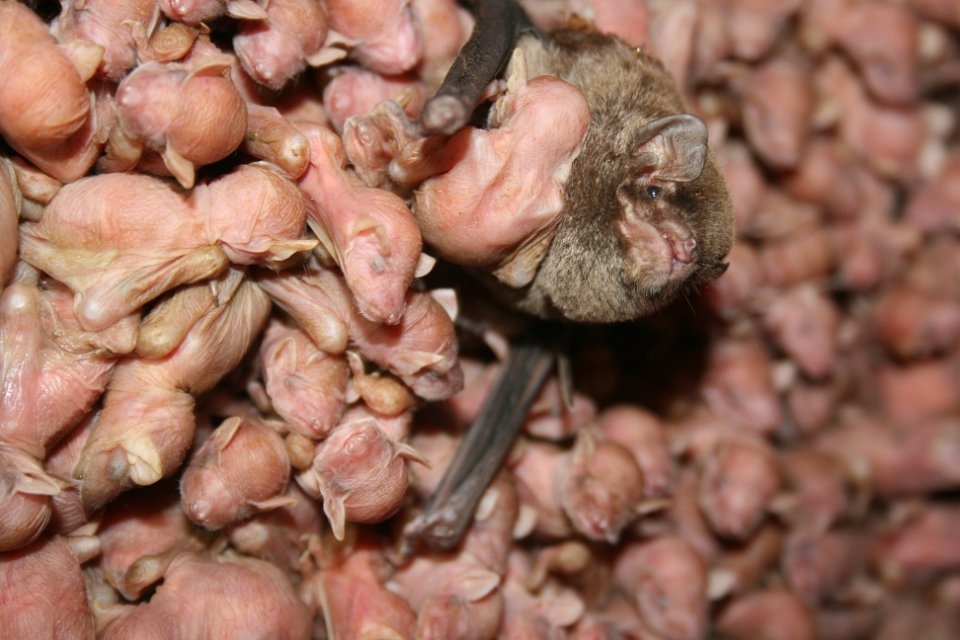
Figure 4: Adult female bat with pup, in amongst the cluster.
Thermal Imaging
In 2008, the author and Terry Reardon from the South Australian Museum learnt that Doug Mills of the New South Wales Parks and Wildlife Service had a thermal imaging camera and had software to count bats. We brought Doug to Naracoorte and conducted a trial. We were quickly convinced that this technology was what we were looking for, a system that could be easily set up, and once calibrated, could provide accurate counts that did not require days of laborious counting.
The technology we are using was developed by the US military for missile tracking. It was adapted for bat counting by Bruce Sabol and Eddie Menton of the US Army Engineer and Research Development Center and is called the Thermal Target Tracker (T3) System. Thermal infrared is a passive sensing technique that takes “heat pictures” by measuring heat radiated by objects. No illumination is required and the resolution of the camera is such that a bat’s body heat is detectable against relatively cooler backgrounds. The continuous flight motion of the bat allows each individual bat to be tracked from frame to frame using the bat’s instantaneous motion vector to predict and detect its position in the next frame (Sabol & Melton, 2008).
Two cameras, Photon 320 30Hz NYSC were purchased, one with a 19 mm wide angle and the other with a 35 mm lens. We purchased the highest resolution cameras that the US Military allow to be exported from the US and waited over five months for them to be delivered. The paperwork was substantial to say the least and I imagine that Terry and I were the subjects of a thorough investigation! The cameras record onto NTSC video cameras with mini DV tapes.

Figure 5: Thermal imaging cameras set up at Bat Cave.
Cool objects are dark and warmer objects lighter with more accurate counts gained with greater contrast between background and the objects being counted. To cool the background, hessian was used and soaked with water prior to the count. This gave an almost black background against which the bats appear quite white. This has been replaced with a permanent colourbond sheet which produces the same effect.
Although we now had the technology to undertake regular counts, it still required substantial effort to set up, record and analyse the data. A request from a Fulbright Scholar from the United States provided the opportunity we needed, someone dedicated to utilising the equipment for 12 months. Kristen Lear completed over 50 counts during 2011-2012, with the highest population count 40,464 in mid February 2012 (Lear, 2012). After this project was completed, the Friends of Naracoorte Caves continued with regular counts from 2013-2015. Population counts have generally been within the range of 33-37,000 at the season peak when juveniles commence flying.
Southern Bentwing Bats only breed at two sites, Bat Cave at Naracoorte and Starlight Cave at Warrnambool. It was reported in 1965 (Dwyer & Hamilton-Smith, 1965) that unlike other species of Miniopterus, males return to the maternity site over the summer months. This has not been tested since and it has been assumed that if this is the case, a count of bats at Bat Cave during summer will include the entire South Australian population. It is now known however, that all bats do not return to Bat Cave, with up to several thousand bats found in what have traditionally been called “wintering sites” over summer (Chris Grant pers. comm.). Regular counts by Lear (2012) demonstrated that nightly counts might vary by more than 10,000, meaning large numbers of bats do not return to Bat Cave each night and utilise other sites during summer. This questions the validity of Bat Cave counts as an accurate population census.
When the counts were undertaken in 1965 by Dwyer and Hamilton-Smith, the district had been through a number of extremely good seasons; in fact 1964 was the wettest year on record (880 mm) for Naracoorte. Good wet seasons would produce an abundance of food and the entire population could be supported living in Bat Cave. The 2008 count followed a number of dry seasons with 2006 the driest year (234mm) on record. It is speculative, but it is possible food resources are substantially lower in the dry periods and male and non-breeding females may use caves elsewhere to enable breeding females to utilise resources closer to Bat Cave. This will be discussed further under determining foraging habitat.
There is now the capacity to count bats easily and accurately as they leave Bat Cave but there are limitations with these data.
- More comprehensive surveys of caves over summer are required to determine if all bats are in Bat Cave.
- Further improvements from a total species population census would be improved if the same technique could be implemented at Starlight Cave at Warrnambool, but given its location and accessibility appears unlikely. Accessing Starlight involves a climbing down a cliff, traversing a rocky shoreline accessible only at low tide and climbing back up the cliff into the cave.
Although we cannot be sure of what percentage of the population is being counted at Bat Cave, accurate counts are nevertheless important. Bat Cave is the largest maternity site and an understanding of annual recruitment levels is valuable information.
Winter surveys
A survey of wintering caves was undertaken by members of the Cave Exploration Group of South Australia (CEGSA) in 1999. Their teams were only able to locate approximately 12,200 bats in their survey conducted over several weekends and made several recommendations on how further surveys could be conducted (Mott & Aslin, 2000). One was to survey all known sites over a single day, to reduce the chances of bats moving from one cave to another overnight, to either be missed completely or counted twice. We also tentatively explored the idea of surveying Victorian caves as well, as they suggested, but lack of knowledge on sites and availability of people made this impossible.
The Department of Environment and Heritage (DEH) coordinated a survey on 6 June 2009. Members of the Friends of Naracoorte Caves and Cave Exploration Group of South Australia (CEGSA) joined DEH staff with 30 people in six teams involved on the day. Surveyors were briefed prior to the count on minimising disturbance, safety, and provided maps and guidelines on how to estimate cluster sizes to ensure a degree on consistency. An estimate of 100 bats per square foot (30cm x30cm) was used. Where large clusters are found, each team member was encouraged to independently estimate the cluster size and estimates were averaged.

Figure 6: A cluster of torpid bats.
The survey was also used to gather;
- Photographs of cave entrances.
- Evidence of feral animals. Cats in particular are predators of bats in caves. They leave tell-tale evidence as they generally eat the entire bat except the wings.
- Evidence of people using caves, such as the remains of light sources, new graffiti or damage to the cave.
- Presence of absence of guano and whether this was fresh or old, determined by white fungus that grows on old fungus.
This information was collated by and became the basis of classifying for on-ground protection and restoration activities. Robertson Cave had previously had an artificial entrance closed in an attempt to restore what was thought to be a maternity site (Baudinette et al., 1994), and many more caves were identified as requiring restorative conservation works.
Unfortunately, the 2009 survey was no more successful at locating what we estimated the total population to be, with only 13,700 bats located. Glencoe West Cave had over 5,000 with five other caves with 1,000 or more. Bats were seen in a further 13 caves of the 40 visited on the day. A number were not visited as landowners refused access and some others have been blocked in recent years. None of the sea caves could be accessed due to high seas so it was likely that more bats were in the region but not found.
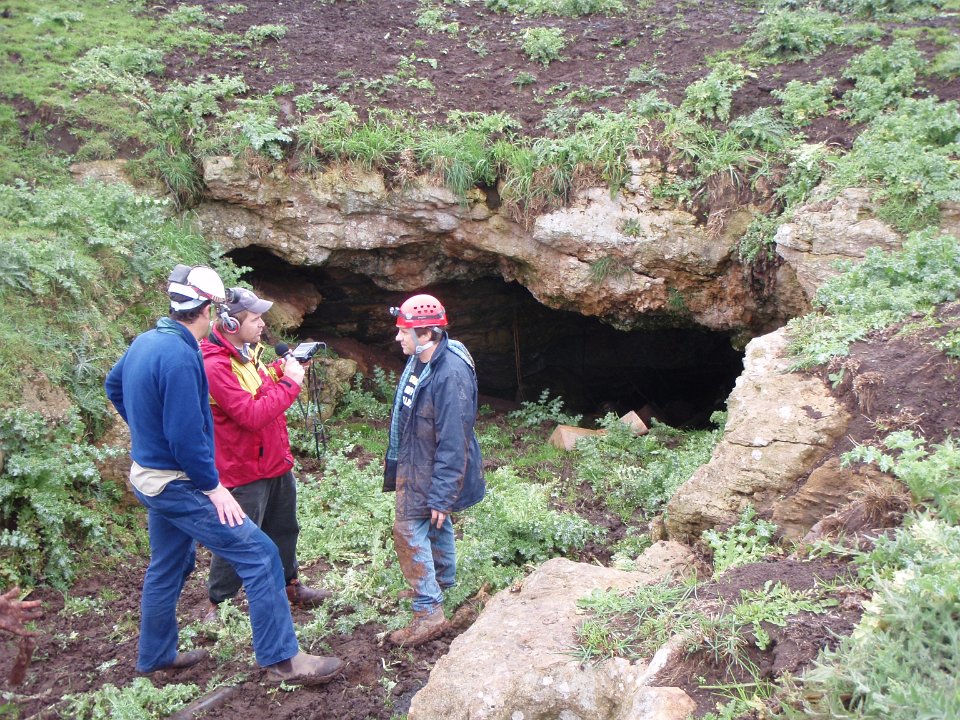
Figure 7: The winter bat counts attracted the media. Here two volunteers are interviewed by ABC radio – an excellent way to raise awareness of the bats.
The 2010 survey included Victorian caves, but despite the significant increase in effort, just 14,900 bats were found. An even more determined effort in 2012, probably aided by improved experience in surveyors, counted 15,300 bats in South Australian caves with around 5,000 located in Victorian caves.
Wintering surveys are of limited value as a population census, but is useful to determine caves important to the species and the level of use of each site. It is extremely labour intensive and even with the use of thermal cameras, finding all of the bats in even a small cave is a very difficult task. Although more than 50 caves in South Australia have been documented as wintering sites, it is likely this is a serious under estimate and many sites are not known. This was recently demonstrated when bats were found in a small cave opened during quarry operations.
Chemical investigations
After the population counts of 2000 and the observations of invertebrate decline, research into possible causes commenced. One line of investigation was pesticide residues. The Australian Government Analytical Laboratories tested guano samples for residues, with two compounds of interest, DDE and methamidophos detected. Although DDE was used as a pesticide in its own right, residues are usually the result of metabolic breakdown of the more widely used DDT (Mispagel et al., 2003, Mispagel et al., 2004, Allinson et al., 2006). Use of DDT was banned in 1987 in Australia, with residues clearly demonstrating its persistence in biological systems.
Twenty bats were sacrificed to allow analysis of chemical loading. Analyses were undertaken at Deakin University, the Australian Government Laboratories and the National Institute for Environmental Studies, Japan. Methamidophos was not detected in tissue samples however, low DDE residues were detected in most samples.
A study was also funded to investigate the chemical usage across the South East of South Australia. This project was severely hampered by the lack of cooperation by chemical suppliers (MacDougal, 2004). She identified a total of 123 pesticide products currently used within major land uses of the region, and frighteningly, a small percentage of users not aware of OH&S requirements relevant to their use of pesticide products!
The southeast region of South Australia is largely cleared, with less than 13% of native vegetation remaining (Croft et al., 1999). The majority of land clearing took place prior to 1960, but there has been an intensification of land use since then. Pesticide use appears to be declining, especially amongst viticulturists as knowledge and awareness (and financial costs) increases.
Determining foraging habitat
Tracking bats to their feeding grounds is difficult; they fly fast, at night and cover vast distances. In 2004, a small project was supported by DEH to gather some information on where Southern Bentwing Bats went to forage. The work formed part of the PhD studies of Chris Grant who developed and coordinated the project (Grant, 2004). Limited data was collected which suggested bats tended to follow the vegetation along the Caves Range with one bat tracked on consecutive nights to its feeding grounds over vineyards approximately 15 kilometres from Bat Cave.
I submitted a grant application on behalf of the Friends of Naracoorte Caves in 2008 which was successful, receiving $16,500 from the World Wide Fund for Nature through the Threatened Species Network. As usual, Terry Reardon from the South Australian Museum offered huge support and greatly assisted with the implementation of the project, which aimed to build on the data gathered in 2004. Ultimately, we hope to identify and conserve habitat required by bats for foraging.
Two sessions of radio tracking were completed in December 2009 and February 2010. We used Holohil transmitters, imported from Canada. The transmitters used are necessarily tiny, weighing just 0.43 grams. An adult bat is 15-16 grams so it equates to less that 3% of the bat’s body weight. Transmitters were attached by trimming the fur and using glue. Each transmitter has a slightly different frequency signal to enable identification of each bat. They operate for up to 21 days but drop off before that. It is not a cheap exercise as the transmitters were $200 each and the plane hire $320 per hour, with the pilot David McTernan providing his time free of charge.
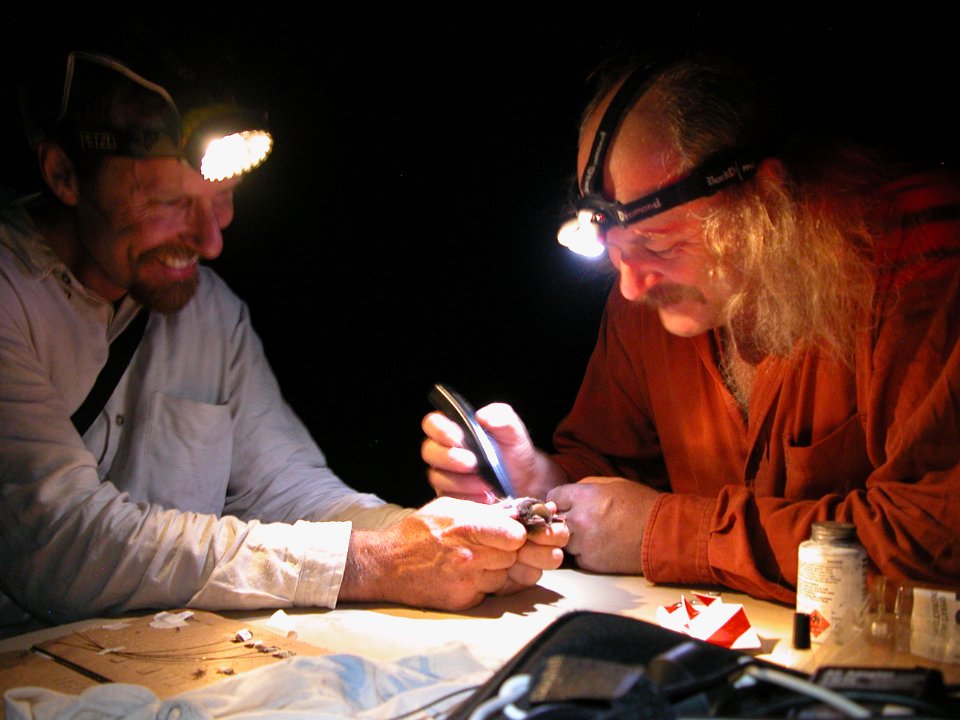
Figure 8: Chris Grant (left) and Terry Reardon attaching a transmitter to a bat.
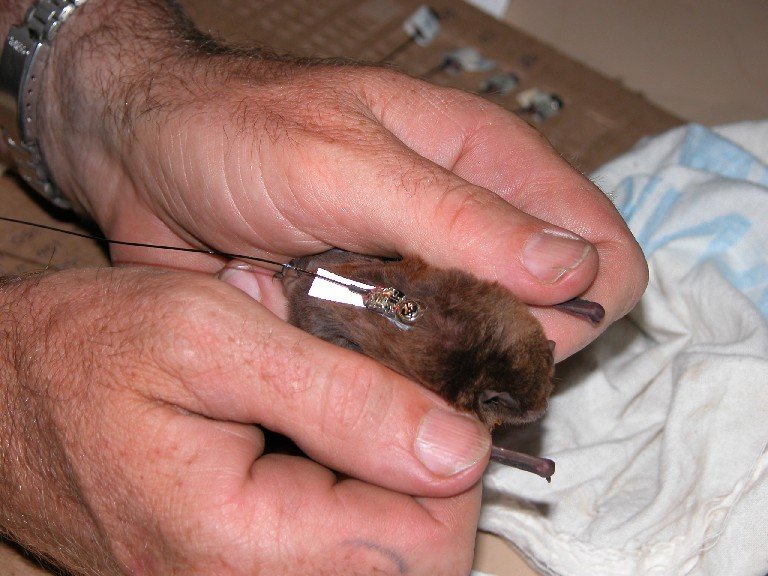
Figure 9: A tiny transmitter attached to a bat.
The tracking sounds simple but in reality is not. The plan is that as a bat with a transmitter emerges from Bat Cave, it will be detected by a receiver at the cave entrance. A crew in a plane flying above is notified, who determines which direction the bat has travelled. Once located, the plane crew provide directions to a ground crew and they follow the bat. The plane crew then tries to locate another bat and repeats the process with another ground crew. A number of issues were encountered;
- Bats don’t follow roads making the task of following in a vehicle difficult.
- Transmitters have a limited range (although 15km is suggested by the supplier)
- Once a bat is lost by the ground crew the plane has to relocate and provide new directions.
The first two nights of tracking we assigned one ground crew to a bat. The third night we assigned two ground crews to each bat, meaning we could only track two bats from the ground. From tests we conducted prior to tracking, we found we had a range of approximately five to six kilometres from the plane. While bats are close to Bat Cave, they are reasonably easily located. As they venture further the distance the plane has to cover greatly increases and the chance of locating them diminishes.
We used Ozi Explorer software on laptops in the plane to maintain current location of the plane, direct ground crews and record waypoints when we passed over a bat. This collected data on the direction each bat travelled and was coupled with data from ground crews.

Figure 10: The plane’s flight path for one night’s tracking. Hardly any wonder we all became disorientated!
The data set is always going to be small when tracking a small number of individuals. We tried a different strategy in February 2010, tracking an individual bat with the plane for as long as we could. Intriguingly, this bat left the cave at the same time on consecutive nights, flew the same path and at the conclusion of two hours tracking, was in the same location 42km from Bat Cave. Unfortunately, a storm prevented a third night’s tracking. It is tantalising to think that bats find a favoured feeding ground so far from the cave and will fly vast distances to reach this and that it is not random.
Invertebrate Studies
The observed decline in guanophilic invertebrate abundance also precipitated investigations in this direction. The first species list for Bat Cave was generated by Hamilton-Smith (Hamilton-Smith, 1967). His observations in 2000 are particularly relevant given his long term knowledge of the site (Hamilton-Smith, 2000). A study by Bellati determined all elements of the community still exist even though there had been a drastic decline, possibly pointing to more subtle cyclical changes (Bellati et al., 2003). A more comprehensive investigation by Moulds (2006) investigated population cycles related to bat habitation of the cave. He found patterns in populations related to presence and absence of bats and confirmed Bellati’s findings that no species had been lost, although the once common cockroaches are now rare. Moulds (2005) highlights that a declining or absent bat population poses a threat to guanophilic invertebrate faunas that rely on a continuous and predictable source of guano. The removal of guano likewise reduces habitat and compaction by unnecessary visits also destroys microhabitat. The exact relationship between bats and invertebrate fauna warrants further investigation to understand what role invertebrates play in lifting temperature and humidity in maternity sites through contributing to the composting process. Hamilton-Smith (2008) posed the question “One of the issues is clearly that with the severely reduced populations today, the temperatures and humidity which once prevailed can no longer be attained. Have we reached a point of no return?” This is a serious issue for this species.

Figure 11: Tim Moulds with field assistant during his PhD research, 2004.
Bat Cave Conservation
One significant threat to this species is access to wintering caves and disturbance while in torpor (Kerr & Bonifacio, 2009). Several caves known to be used by bats have been filled in by landowners and access to other compromised by rubbish. The Friends of Naracoorte Caves cleaned out Cave Park Cave in July 2004, removing 15 200 litre drums of metal and glass from the cave, as well as a car. A corridor of native vegetation was established around the cave entrance and to Mosquito Creek about 300 metres from the cave. This corridor contributes to a larger project linking areas of remnant vegetation along the Caves Range and it is hoped this will provide protection around the cave and a flight path for bats to vegetation. Radio tracking observations by Grant (2004) and repeated in 2009/10 suggests the bats tend to follow vegetation when moving to feeding areas.
Joanna Bat Cave was also cleaned as part of the Australian Government Envirofund project, with the majority of work completed by a Green Corps team. Approximately 30 tonnes of rubbish, primarily wire and other assorted metal was removed from the cave. Removing a tank blocking the entrance to the cave proved rather challenging but the entrance is now completely free of restriction. In keeping with the aims of the project, the metal was recycled.
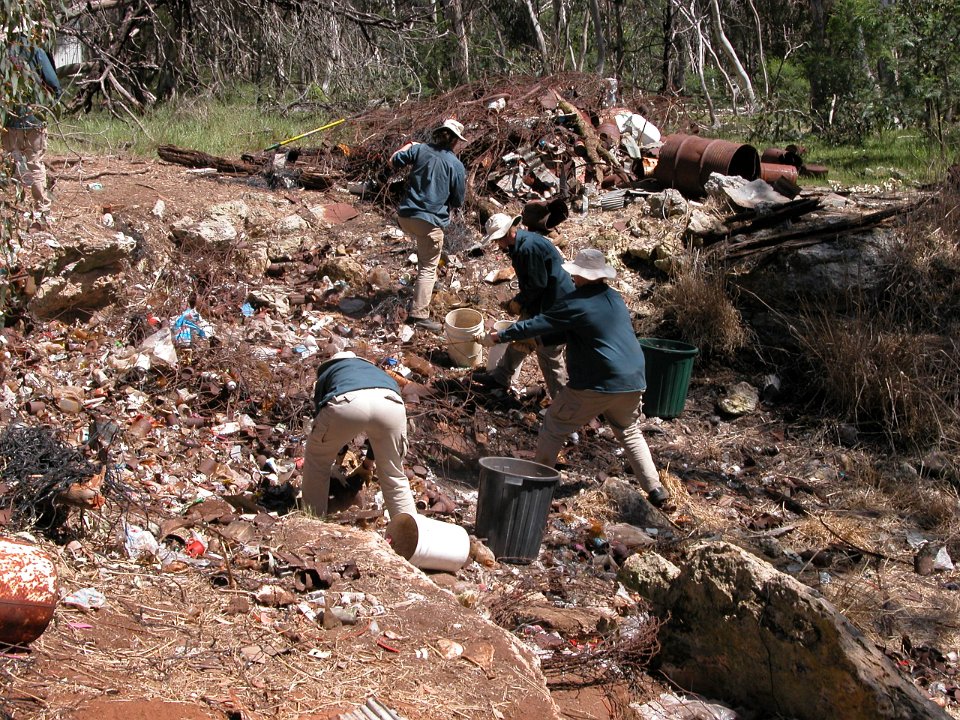
Figure 12: Green Corps team cleaning rubbish out of Joanna Bat Cave

Figure 13: Joanna Bat Cave free of rubbish.
It is interesting to note Hamilton-Smith regularly observed thousands of bats in this cave in the 1960s (from notes with bat banding records), yet in recent years no more than 30 had been seen at once. Although human access was possible around the tank, it appeared to prevent bats from regularly using the cave. Just a few weeks after the tank was removed in October 2004, several hundred bats were seen in the cave.
Such a good result for conservation would not have been achieved without cooperative landowners.
Disease outbreak
In September 2009, one of the Naracoorte Caves Site Interpreters reported seeing something that appeared to be an ulcer on an adult bat via the infrared cameras. A visit was made into the cave for a closer inspection to determine whether this was a single occurrence or something more sinister. The cave visit raised serious concerns as over 50% of the bats inspected had white raised ulcers 1-2mm across, all on bare skin. I contacted people who had previously been involved with the December 2008 investigation into lesions found on pups and received an excellent response. Ten bats were caught and sent to Adelaide for emergency testing.
Investigations were undertaken by Dr David McLelland from the Adelaide Zoo. A permit was secured and ten bats, all males, were caught and sent to Adelaide for analysis. The initial analyses identified parasites were responsible for the majority of ulcers with one attributed to a pox virus. This is particularly significant as pox viruses, as far as we could determine, had not been previously found in bats (McLelland et al., 2009). Samples were submitted to the Australian Animal Health Laboratory in Victoria, Gribbles Laboratory and to a parasitologist Dr Ian Beveridge at Melbourne University.
David and Dr Wayne Boardman from the Adelaide Zoo, Celia Dickason from PIRSA and Terry Reardon from the South Australian Museum undertook further investigations at Naracoorte. Rather that euthanasia, operations were conducted under anaesthesia - a particularly delicate exercise! We trapped 125 bats and operated on 18. Interestingly, ulcers were more prevalent on male bats with females generally pregnant and healthy. Very pleasingly, the percentage of bats with ulcers was much less and they were generally less severe than were observed a month earlier. The majority of ulcers were determined to be a nematode parasite Riouxgolvania beveridgei, which was described in 1965 from specimens found in Miniopterus in Queensland (Bain & Chahoud, 1979).
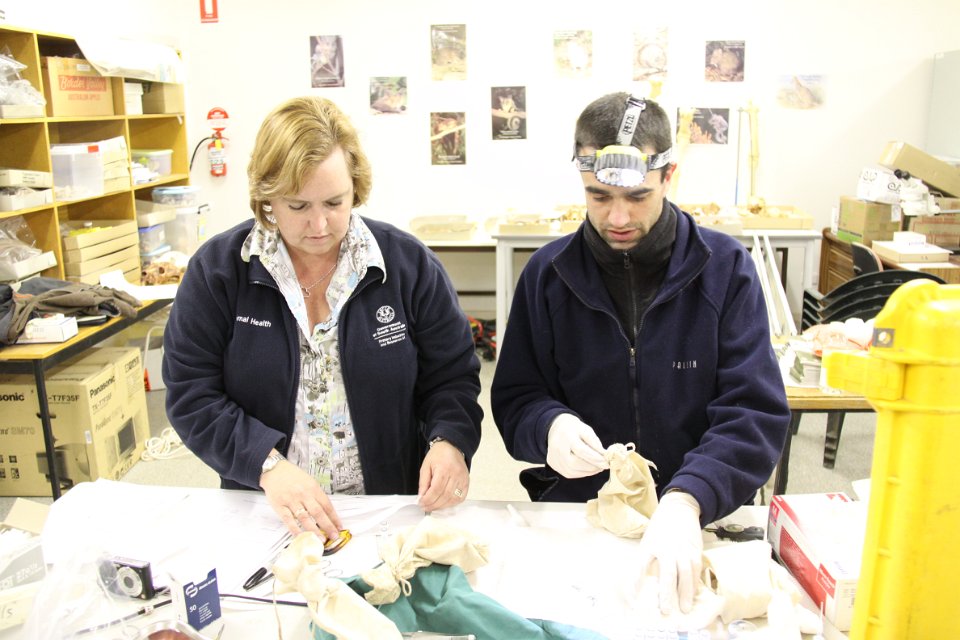
Figure 14: Celia Dickason and David McLelland operating to remove ulcers from bats for analysis.
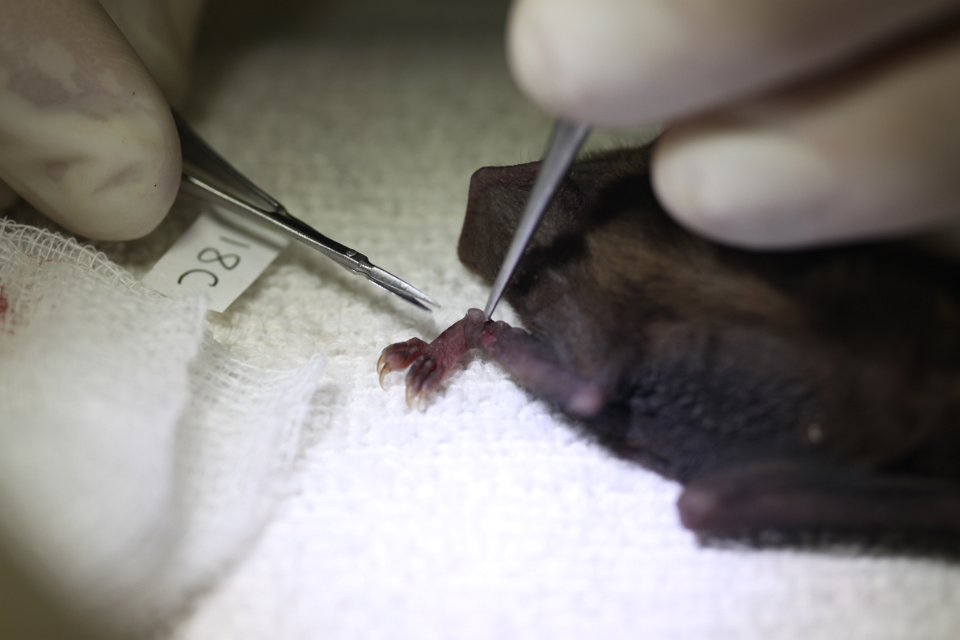
Figure 15: The delicate surgery.
These investigations were generously supported by PIRSA who treated the outbreak as a biosecurity risk. The support from Adelaide Zoo vets, testing laboratories and universities was outstanding and an excellent network has been established should the need arise again.
In 2006, pup mortality was high with the dry season suggested as the cause (Bourne & Hamilton-Smith, 2007). The 2008 season saw similar mortality but some pups had lesions as well as malnutrition. Breeding seasons from 2009 to 2014 have been more favourable and recruitment appears to have been more successful. The counts however, do not indicate any significant increase in numbers. It would appear the species is particularly susceptible to dry conditions, as they rely on cave water for drinking in the cave, particularly while lactating (Codd et al., 1999) and surface water to produce a healthy insect population as a food source.
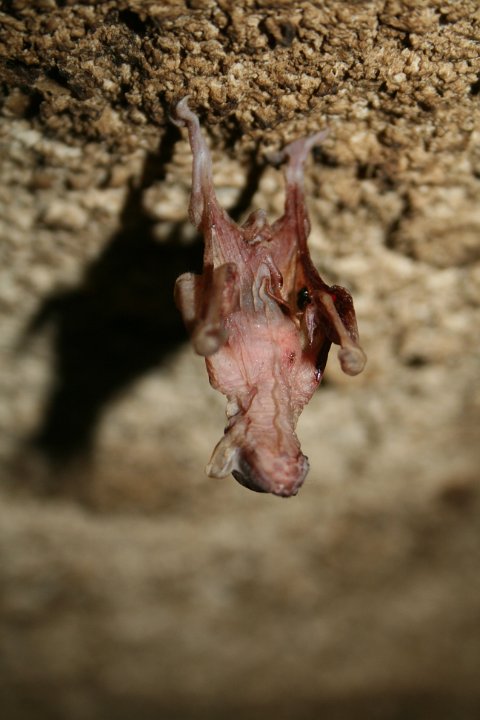
Figure 16: Bat pup with severe lesions and injuries. The cause for such severe injuries has yet to be determined, and only observed in 2008.

Figure 17: Dying pups on the cave floor, December 2008.
National Recovery Plan for the Southern Bent-wing Bat Miniopterus schreibersii bassanii
A draft recovery plan was released in early 2015 (Lumsden & Jemison, 2015). The specific objectives of this recovery plan are to:
- Develop techniques to accurately estimate the population size at the maternity sites and undertake regular assessments of population numbers to thoroughly document population trends. Determine the main cause/s of the recent decline in numbers of Southern Bent-wing Bats, and develop targeted, rapid management responses. Protect the maternity sites and other key non-breeding sites. Protect and enhance foraging habitat around the maternity sites and key non-breeding sites. Clarify the taxonomic status, distribution and population structure of the Southern Bent-wing Bat. Compile and maintain databases to aid in the management of the subspecies. Establish a long term monitoring program for the Southern Bent-wing Bat. Facilitate and promote community interest, understanding and participation. Provide direction and guidance to the recovery of the Southern Bent-wing Bat and review the success of this Recovery Plan.
Research at Naracoorte Caves National Park over the past 15 years has sought to build our knowledge of this subspecies of Miniopterus schreibersii, and has attempted to address, or at least start addressing some of the objectives in the recovery plan. The lack of progress highlights the challenges in studying a fast flying, nocturnal, cave dwelling animal. At the time of writing, two students have commenced PhD projects and it is to be hoped this is the start of a coordinated and concentrated effort to further increase our understanding of Miniopterus schreibersii bassanii.

Figure 18: Composite image used for promotion of bat tours at Naracoorte Caves.
References
Allinson, G., Mispagel, C., Kajiwara, N., Anan, Y., Hashimoto, J., Laurenson, L., Allinson, M. and Tanabe, S. (2006). Organochlorine and trace metal residues in adult southern bent-wing bat (Miniopterus schreibersii bassanii) in southeastern Australia. Chemosphere 64:1464-1471.
Appleton, B. R., J. A. McKenzie, and L. Christidis. (2004). Molecular systematics and biogeography of the bent-wing bat complex Miniopterus schreibersii (Kuhl, 1817) (Chiroptera: Vespertilionidae). Molecular Phylogenetics and Evolution 31:431-439.
Bain, O. and Chabaud, A.G. (1979) Sur les Muspiceidae (Nematoda-Dorylaimina). Annule de Parasitologie.
Baudinette, R. V., Wells, R. T., Sanderson, K. L., and Clark, B. (1994). Microclimatic conditions in maternity caves of the bent-wing bat, Miniopterus schreibersii: an attempted restoration of a former maternity site. Wildlife Research 21:607-619.
Bellati, J., Austin, A.D., and Stevens, N.B. (2003). Arthropod diversity of a guano and non-guano cave at the Naracoorte Caves World Heritage Area, South Australia. Records of the South Australian Museum Monograph Series 7, 257-265.
Bourne, S.J. and Hamilton-Smith, E. (2007). Miniopterus schreibersii bassanii and climate change. The Australian Bat Society Newsletter 28:67-69.
Bourne, S.J. (2010) Bat Research at Naracoorte. Journal of the Australasian Cave and Karst Management Association. No. 78.
Bourne, S.J. (2010a). Bat research at Naracoorte. The Australasian Bat Society Newsletter 34, 24-29.
Cardinal, B. R., and L. Christidis. (2000). Mitochondrial DNA and morphology reveal three geographically distinct lineages of the large bentwing bat (Miniopterus schreibersii) in Australia. Australian Journal of Zoology 48:1-19.
Codd, J. R., B. Clark, and K. J. Sanderson. (1999). Drinking by the common bent-wing bat Miniopterus schreibersii and calcium in cave water. Bat Research News 40:9-10.
Croft, T., Carruthers, S., Possingham, H. and Inns, B. (1999). Biodiversity Plan for the South East of South Australia. Department for Environment, Heritage and Aboriginal Affairs.
Duncan, A., Baker, G. B. and Montgomery, N. (1999). The Action Plan for Australian Bats. Biodiversity Group, Environment Australia, Canberra, ACT.
Dwyer, P. D., and Hamilton-Smith, E. (1965). Breeding caves and maternity colonies of the bent-winged bat in south-eastern Australia. Helictite 4:3-21.
Grant, C. (2004). Radiotracking of Miniopterus schreibersii at Naracoorte, South Australia. Department for Environment and Heritage, Mt Gambier.
Hamilton-Smith, E. (1967). The Arthropoda of Australian caves. Journal of the Australian Entomological Society 6, 103-118.
Hamilton-Smith, E. (1998). Much ado about very little: bat (Miniopterus shreibersii) guano mining at Naracoorte, South Australia. Australian Zoologist 30(4).
Hamilton-Smith, E. (2008). Miniopterus bassanii : Some comments on its endangered status. Unpublished note.
Hamilton-Smith, E. (2000). Report on current changes in biodiversity of the Bat cave, Naracoorte World Heritage Area. Report to Department for Environment and Heritage.
Kerr, G.D. and Bonifacio, R.S. (2009). Regional Action Plan for the Southern Bent-wing Bat Miniopterus schreibersii bassanii in the South East of South Australia. Department for Environment and Heritage.
Lear, K. (2012). An American in Australia: Monitoring the maternity colony of Southern Bentwing Bats (Miniopterus schreibersii bassanii) at Naracoorte Caves National Park, South Australia. Journal of the Australasian Cave and Karst Management Association. No. 86.
Lumsden, L. F. and Jemison, M.L. (2015). National Recovery Plan for the Southern Bent-wing Bat Miniopterus schreibersii bassanii. Victorian Government Department of Environment, Land, Water and Planning (DELWP) East Melbourne.
MacDougal, S. (2004). Toward the conservation of Miniopterus schreibersii bassanii: An investigation into the patters of pesticide use in the lower south east region of South Australia. Unpublished honours thesis, Deakin University, Victoria.
McLelland, D.J., Boardman, W., Bourne, S., Dickason C., Kessell, A., Hyatt, A., Middleton, D., Beveridge, I., Clark, P. and Reardon, T. (2009). Investigation of Nodular Skin Disease and Pup Mortality in Southern Bentwing Bats (Miniopterus schreibersii bassanii) at Naracoorte Caves, South Australia. Wildlife Disease Association.
Mispagel, C., Allison, G. and Allinson, M. (2003). Pesticide residues in the Southern Bent-winged Bat. Report to Department for Environment and Heritage.
Mispagel, C., Allison, M., Allinson, G., Iseki, N., Grant, C., and Morita, M. (2004). DDT and metabolite residues in the southern bent-wing bat (Miniopterus schreibersii bassanii) of south-eastern Australia. Chemosphere 55:997-1003.
Mott, K., and Aslin, F. (2000). Distribution of Miniopterus schreibersii in wintering sites throughout the south east of South Australia. Project 7/82. National Parks Foundation of South Australia.
Moulds, T. (2005). Guanophilic invertebrate ecology and conservation in caves. Proceedings of the Australasian Cave and Karst Management Conference, Westport, New Zealand.
Moulds, T. (2006). The seasonality, diversity and ecology of caverniculous guano dependent ecosystems in southern Australia. Unpublished PhD thesis, University of Adelaide, South Australia.
Reardon, T.B. (2001). Population size estimates and conservation of the Southern bentwing bat (Miniopterus bassanii) in South Australia. Report to Wildlife Conservation Fund Committee.
Sabol, B.M. & Melton, R.E. (2008) Users Guide: The Thermal Target Tracker (T3) System (version 1.0) for Censusing Bats in Flight.